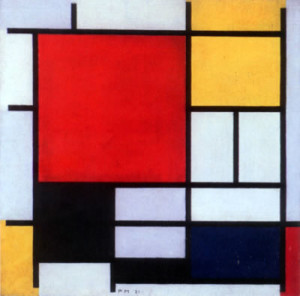Piet Mondrian is an Holland artist who started the Neo-platisticism (plastic art) movement in Modern Art. He believed in simplification of art and a movement away from traditional realistic art. He worked with the three primary colours (red, blue, and yellow), as well as the achromatic colours (grey, black, and white). It is interesting to note that his father was an elementary school teacher who was an art enthusiastic who gave Mondian drawing lessons. Also, Mondian’s uncle was an artist who influenced Mondian and his artwork.
Mondian started off influenced by Cubism in art as reflected in his earlier works. But towards the end, he stripped art down to just focusing on line and colour, rejecting the 3-Dimensionness of Cubism.
Lesson Idea:
I would explore the idea with the kids that art is not just about interpretation from observation, but also considering the importance of reading into what compelled an artist to use the materials that they did and the way they used those materials to form their artworks. Also, to learn more about the artist’s motivations for creating that artwork: political, emotional, etc. and to teach the students the importance of reading didactic panels to really understand the artwork in its entirety. I would introduce it as a “Things aren’t all they seem” theme and you have to delve into something to get the real answer. I would introduce a series of subject lessons where students will be asked to grapple with problems that have complex solutions. For example, in Ethics, students will be asked to cooperatively solve ethical questions where they would all need to contribute their ideas unto chart paper and talk about it (making sure that each student gets a chance to share and contribute their ideas). Then they will need to come to a consensus on what they best plan of action would be to follow. The answer will not be in black or white and students will need to contribute any evidence they can think of and their moral reasoning behind it. This art lesson will help students practice deconstructing and considering all the different elements that can influence the artist’s decisions in making the choices that he did in his art (i.e. role models, upbringing, views of the time, emotional state at the time, etc.).

